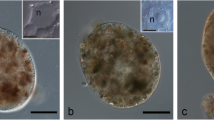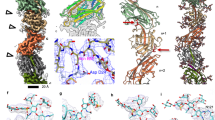Summary
An extensive fibrillar network inAmoeba villosa is described. The width of its meshes variates in large limits, indicating a high plasticity. Likewise the size of the observed network variates in the special cases. During the drying-process the fibrils sometimes dissociate into a globular substance which frequently becomes a membranous state. Fibrils ending freely in the protoplasm show typical tension-figures, indicating torsions and rotations of these fibrils. The observed structures probably correspond with the fibrils demonstrated inTrichamoeba villosa by the electron microscope. The significance of this fibrillar network and some other problems are discussed.
Zusammenfassung
Es wird ein ausgedehntes Fibrillennetz beiAmoeba villosa beschrieben. Seine Maschenweite ist in weiten Grenzen variabel, was auf eine hohe Plastizität hindeutet. Ebenfalls sehr variabel ist die Größe des jeweils dargestellten Fibrillennetzes. Bei der Entquellung lösen sich die Fibrillen manchmal in eine globuläre Substanz auf, die oft in eine membranartige Zustands-form übergeht. Frei im Protoplasma endende Fibrillen zeigen typische Spannungsformen, die auf Torsionen und Rotationen dieser Fibrillen hinweisen.
Die dargestellten Strukturen entsprechen wahrscheinlich den im Elektronenmikroskop beiTrichamoeba villosa gefundenen Fibrillen. Die Bedeutung dieses Fibrillennetzes sowie ver-schiedene andere Probleme werden diskutiert.
Similar content being viewed by others
Literatur
Allen, R. D., D. W. Francis, andHiromichi Nakajima, 1965: Cyclic birefringence changes in pseudopods ofChaos carolinensis revealing the localization of the motive force in pseudopod extension. Proc. nat. Acad. Sci.54, 1153–1161.
Bhowmick, D. K., andK. E. Wohlfarth-Bottermann, 1965: An improved method for fixingAmoebae for electron-microscope. Exp. Cell Res.40, 252–263.
—, 1967: Electron microscopy ofTrichamoeba villosa and amoeboid movement. Exp. Cell Res.45, 570–584.
Chatton, E., etA. Lwoff, 1930: Impregnation, par diffusion argentique, de l'Infra-ciliature des Cilies marins et d'eau douce, après fixation cytologique et sans dessication. Compt. rend.104, 834–836.
Foissner, W., 1967: Wimpertiere im Silberpräparat. Ein verbessertes „trockenes“ Ver-fahren zur Darstellung des Silberliniensystems. Mikrokosmos4, 122–126.
—, 1969: Reaktionen des Silberliniensystems der Ciliaten auf mechanische Insulte. I. Teil. Protoplasma68, 23–45.
—, 1969: Reaktionen des Silberliniensystems der Ciliaten auf mechanische Insulte. II. Teil. Protoplasma68, 433–456.
Gelei, J. v., 1934: Amöbenforschung und Silbermethoden. Zool. Anz.108, 92–95.
—, 1934: Eine mikrotechnische Studie über die Färbung der subpelliculären Elemente der Ciliaten. Z. wiss. Mikrosk. und mikrosk. Tech.51, 103–178.
Goldacre, R. J., 1961: The role of the cell membrane in the locomotion of amoebae, and the source of the motive force and its control by feedback. Exp. Cell Res. (suppl.)8, 1–16.
Jahn, T. L., 1964: Protoplasmic flow in the mycetozoan,Physarum-II. The mechanism of flow; a re-evaluation of the contraction-hydraulic theory and of the diffusion drag hypothesis. Biorheology2, 133–152.
Jarosch, R., 1965: Über Kontakt und Verzweigung der Protein-Schrauben. Österr. Bot. Z.112, 500–542.
—, 1968: Zur Dynamik feiner Pseudopodien von Hochmoor-Amöben. Protoplasma65, 363–377.
—, 1968: Konfiguration und Hydrodynamik protoplasmatischer Schrauben. Z. Natur-forsch.23 b, 17–24.
- 1971: Vergleichende Studien zur amöboiden Beweglichkeit. Protoplasma (im Druck).
Kamiya, N., 1966: Motilität des Plasmas der lebenden Zelle. Naturwiss. Rundschau19, 270–282.
- 1968: The mechanism of cytoplasmic movement in a myxomycete plasmodium. Aspects Cell Mot. 200–214.
— andK. Kuroda, 1965: Movement of the myxomycete plasmodium. I. A study of glycerinated models. Proc. Japan Acad.41, 837–841.
Käppner, W., 1961: Bewegungsphysiologische Untersuchungen an der AmöbeChaos chaos. I. und II. Teil. Protoplasma53, 81–105, 504–529.
Klein, B. M., 1926: Über eine neue Eigentümlichkeit der Pellikula vonChilodon uncinatus Ehrbg. Zool. Anz.67, 1–2.
— 1932: Das Ciliensystem in seiner Bedeutung für Lokomotion, Koordination und Form-bildung mit besonderer Berücksichtigung der Ciliaten. Erg. Biol.75, 75–171.
—, 1942: Das Silberlinien- oder neuroformative System der Ciliaten. Ann. Naturhist. Mus. Wien53, 156–336.
— 1958: The “dry” silver method and its proper use. J. Protozool.5, 99–103.
Komnick, H., undK. E. Wohlfarth-Bottermann, 1965: Das Grundplasma und die Plasmafilamente der AmöbeChaos chaos nach enzymatischer Behandlung der Zell-membran. Z. Zellforschung66, 434–456.
Nagai, R., andN. Kamiya, 1968: Movement of the myxomycete plasmodium. II. Electron microscopic studies on fibrillar structures in the plasmodium. Proc. Japan Acad.42, 934–939.
—, 1968: Movement of the myxomycete plasmodium. VI. Fibrillar structures in the glycerinated plasmodium. Proc. Japan Acad.44, 1044–1047.
Takata, T., R. Nagai, andN. Kamiya, 1967: Movement of the myxomycete plasmodium. III. Artificial polarization in endoplasm distribution in a plasmodium and its bearing on protoplasmic streaming. Proc. Japan Acad.43, 45–50.
Wohlfarth-Bottermann, K. E., 1961: Cytologische Studien. VII. Strukturaspekte der Grundsubstanz des Cytoplasmas nach Einwirkung verschiedener Fixierungsmittel. Untersuchungen am Hyaloplasma von Amöben derLimax- undProteus-Gruppe. Protoplasma53, 259–290.
— 1962: Weitreichende, fibrilläre Protoplasmadifferenzierungen und ihre Bedeutung für die Protoplasmaströmung. I. Teil. Protoplasma54, 514–539.
— 1963: Weitreichende, fibrilläre Protoplasmadifferenzierungen und ihre Bedeutung für die Protoplasmaströmung. II. Teil. Protoplasma57, 747–761.
— 1964: Cell structures and their significance for ameboid movement. Int. Rev. Cytol.16, 61–131.
— 1968: Dynamik der Zelle. Mikroskopie23, 71–96.
Author information
Authors and Affiliations
Rights and permissions
About this article
Cite this article
Foissner, W. Ein argyrophiles Fibrillensystem beiAmoeba villosa (Wallich). Protoplasma 72, 191–201 (1971). https://doi.org/10.1007/BF01279050
Received:
Issue Date:
DOI: https://doi.org/10.1007/BF01279050




